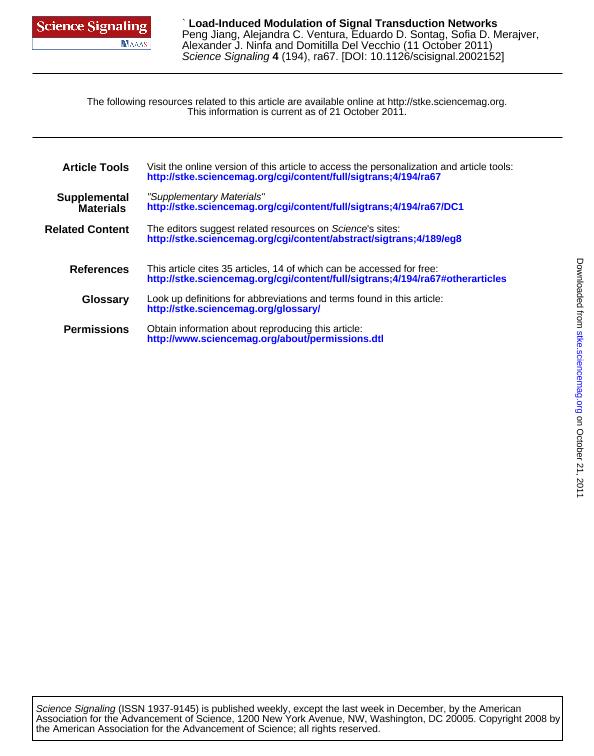Mostrar el registro sencillo del ítem
dc.contributor.author
Jiang, Peng
dc.contributor.author
Ventura, Alejandra

dc.contributor.author
Sontag, Eduardo D.
dc.contributor.author
Merajver, Sofia D.
dc.contributor.author
Ninfa, Alexander J.
dc.contributor.author
Del Vecchio, Domitilla
dc.date.available
2019-11-07T18:00:24Z
dc.date.issued
2011-10
dc.identifier.citation
Jiang, Peng; Ventura, Alejandra; Sontag, Eduardo D.; Merajver, Sofia D.; Ninfa, Alexander J.; et al.; Load-induced modulation of signal transduction networks; American Association for the Advancement of Science; Science Signaling; 4; 194; 10-2011; 1-10
dc.identifier.issn
1937-9145
dc.identifier.uri
http://hdl.handle.net/11336/88188
dc.description.abstract
Biological signal transduction networks are commonly viewed as circuits that pass along information—in the process amplifying signals, enhancing sensitivity, or performing other signal-processing tasks—to transcriptional and other components. Here, we report on a “reverse-causality” phenomenon, which we call load-induced modulation. Through a combination of analytical and experimental tools, we discovered that signaling was modulated, in a surprising way, by downstream targets that receive the signal and, in doing so, apply what in physics is called a load. Specifically, we found that non-intuitive changes in response dynamics occurred for a covalent modification cycle when load was present. Loading altered the response time of a system, depending on whether the activity of one of the enzymes was maximal and the other was operating at its minimal rate or whether both enzymes were operating at submaximal rates. These two conditions, which we call “limit regime” and “intermediate regime,” were associated with increased or decreased response times, respectively. The bandwidth, the range of frequency in which the system can process information, decreased in the presence of load, suggesting that downstream targets participate in establishing a balance between noise-filtering capabilities and a circuit’s ability to process high-frequency stimulation. Nodes in a signaling network are not independent relay devices, but rather are modulated by their downstream targets.
dc.format
application/pdf
dc.language.iso
eng
dc.publisher
American Association for the Advancement of Science

dc.rights
info:eu-repo/semantics/openAccess
dc.rights.uri
https://creativecommons.org/licenses/by-nc-sa/2.5/ar/
dc.subject
BIOCHEMISTRY AND MOLECULAR BIOLOGY
dc.subject
CELL BIOLOGY
dc.subject
CASCADES
dc.subject
INSULATION
dc.subject.classification
Otras Ciencias Físicas

dc.subject.classification
Ciencias Físicas

dc.subject.classification
CIENCIAS NATURALES Y EXACTAS

dc.title
Load-induced modulation of signal transduction networks
dc.type
info:eu-repo/semantics/article
dc.type
info:ar-repo/semantics/artículo
dc.type
info:eu-repo/semantics/publishedVersion
dc.date.updated
2019-09-30T15:24:16Z
dc.journal.volume
4
dc.journal.number
194
dc.journal.pagination
1-10
dc.journal.pais
Estados Unidos

dc.description.fil
Fil: Jiang, Peng. University of Michigan; Estados Unidos
dc.description.fil
Fil: Ventura, Alejandra. Consejo Nacional de Investigaciones Científicas y Técnicas. Oficina de Coordinación Administrativa Ciudad Universitaria. Instituto de Fisiología, Biología Molecular y Neurociencias. Universidad de Buenos Aires. Facultad de Ciencias Exactas y Naturales. Instituto de Fisiología, Biología Molecular y Neurociencias; Argentina. Universidad de Buenos Aires. Facultad de Ciencias Exactas y Naturales. Departamento de Fisiología, Biología Molecular y Celular. Laboratorio de Fisiología y Biología Molecular; Argentina
dc.description.fil
Fil: Sontag, Eduardo D.. Rutgers University; Estados Unidos
dc.description.fil
Fil: Merajver, Sofia D.. University of Michigan; Estados Unidos
dc.description.fil
Fil: Ninfa, Alexander J.. University of Michigan; Estados Unidos
dc.description.fil
Fil: Del Vecchio, Domitilla. Massachusetts Institute of Technology; Estados Unidos
dc.journal.title
Science Signaling

dc.relation.alternativeid
info:eu-repo/semantics/altIdentifier/url/https://stke.sciencemag.org/content/4/194/ra67
dc.relation.alternativeid
info:eu-repo/semantics/altIdentifier/doi/http://dx.doi.org/10.1126/scisignal.2002152
Archivos asociados
